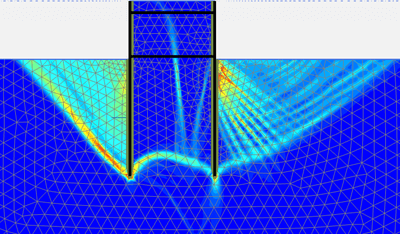
For retaining structures with large loads or limited width a cofferdam will often be the suitable solution. Cofferdams can be created in many forms eg. cellular structures or double-wall sheet pile structures. Much of the theory is however independent of the form of the cofferdam.
The double-wall sheet pile cofferdam in Aarhus Habour is designed, the cofferdam is part of the construction pit for the new media house in Aarhus. Its installed on the seabed, of the existing basin, which consist of mainly soft clay. The design have been done using both an analytical calculation and a numerical model using Plaxis 2D. All theory behind has been described and choices regarding the design have been explained.
It has been shown that the stability of the cofferdam is sufficient at an installation level of -21m according to Eurocode 7. This is verified both with the analytical approach and the numerical model. However it has been shown that no present analytical theory is able to design the individual sheet piles and anchors. Also flaws in the analytical theory have been shown for cofferdams of great depth or high loads. And an alternative theory has been presented.
Using a sensitivity analysis its shown that the stability is highly sensitive to the wall friction, the angle of internal friction, the cohesion and to lesser extent the amount of cohesion for the active earth pressure. Based on this analysis several proposals regarding calculation inputs are put up for discussion.
This article comes from studerende edit released

